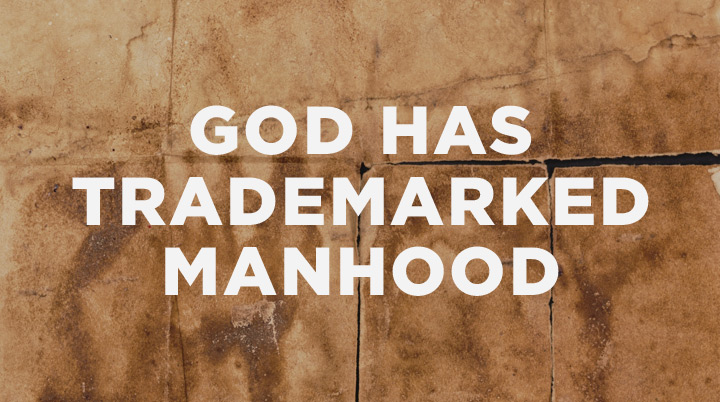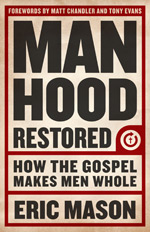Latest
-
Objections to the Christian Faith from the Unchurched and De-Churched
 Tue Dec 02, 2014
Tue Dec 02, 2014
by Resurgence -
Craig Groeschel: We Innovate for Jesus
 Tue Oct 14, 2014
Tue Oct 14, 2014
by Resurgence -
Mark Driscoll: Revelation
 Tue Oct 07, 2014
Tue Oct 07, 2014
by Resurgence -
RESURGENCE LEADERSHIP #034: JOHN PIPER, WHY I TRUST THE SCRIPTURES, PART 2
 Tue Sep 30, 2014
Tue Sep 30, 2014
by Resurgence -
Resurgence Leadership #033: John Piper, Why I Trust the Scriptures, Part 1
 Tue Sep 23, 2014
Tue Sep 23, 2014
by Resurgence

Archives
God has trademarked manhood

An excerpt from Eric Mason’s important new book, Manhood Restored. Follow Resurgence on Twitter to win one of 10 copies this Sunday, June 9!
In an interview with Bryan “Baby” Williams, leader of the Young Money Cash Money Billionaires hip-hop group, a question was raised about the term bling-bling. This term is a colloquialism used first in hip-hop culture to speak about the mass accumulation of material wealth. In this culture, every time there is an accomplishment that leads to gaining more wealth, “bling-bling” is announced to self and others as a way of saying that more has been brought into one’s possession.
In regard to the term, Baby stated, “I wish we would have trademarked that phrase ’cause we originated it. People would have to pay us every time they used the term and it would trace them back to us” [paraphrase].
That’s how trademarking works. It’s a claim on something original or unique that establishes ownership. Many might use, build on, or add something to the original, but the trademark establishes the absolute first origin of something. It’s important in business—it’s more important in creation.
Man as God’s creative work
God holds the trademark on creation. More specifically, God holds the trademark on manhood. All of God’s creation was brought into being with a sense of care and love, but when he created man he didn’t speak him into existence as he did the stars, water, land, and animals. Instead God innovated a new technique in creation: God formed man. This term is rich in depth and meaning—God handmade man by sculpting him from what he had already created.
Genesis 1:26–28 is considered a summary statement of the creation of both men and women. In that summary, though, we find a statement of purpose along with mere description. The key is in the word image. Those five letters are jam-packed with fundamental theological truth that gives us insight not only into God’s original intent in human creation, but also his ongoing purpose for us in the world.
Work is a key part of who we are as men.
Man was meant to function like a mirror—something to reflect the image of God into creation. Humanity, made in the image of God, was created to be an earthly representation of who God is. In man’s God-given dominion and rule over creation, he was to display the ultimate rule of God in his limited dominion.
Working men
As an image-bearer, man was to reflect God’s heavenly reign on earth. In other words, man represents God by virtue of being in his image. In representing God, man was to glorify the God who created him.
This is an incredible responsibility. Both Genesis 1:28 and 2:15 describe this responsibility as the act of subduing and caring for creation. In subduing creation, man is given the ability to use it for his personal benefit on God’s terms. In that light, the command in Genesis 1:28 might be paraphrased like this: “Harness its potential and use its resources for your benefit” (Note #58).
Man was called to subdue, care, and rule in God’s name.
The word care in Genesis 2:15 (NIV) carries a similar sense. The man is called “to work it and keep” (ESV) the garden. In essence, this responsibility was a job.
Whenever we talk about this at our church, Epiphany Fellowship, the women go crazy. They love hearing that the man got a job before he had a woman! Work was good in those days—more than good, in fact. Then and now, in a redeemed sense, work is a key part of who we are as men.
Man was called to subdue. And he was called to care. But he was also called to rule. In ruling they would serve as God’s vice-regents (a person who acts in the name of another) on Earth. This rule was not to be done with an iron fist. If humans were really going to reflect the image of God’s rule on their own, they would accept the responsibility of seeing to the welfare of that which is put under them and the privilege of using it for their benefit.
Imaging in relationship
We need to be careful here that we don’t miss one of the chief components of being God’s image-bearer. As an image-bearer, man is to subdue. He is to care and work. And he is to rule. All these components are key, but what is missing up to this point is the relationship.
Having a relationship with Yahweh was what made image-bearing more than just some sort of political appointment. God designed humans with a unique capacity for relationship because it was his intent that this centerpiece of his creation, man and woman, would be relationally connected to him for eternity. Without relationship, none of the other aspects of being an image-bearer would matter.
Jesus restores manhood
In the gospel, Jesus is restoring our vision of manhood. He is blowing up our own versions of what it means to be a man with his own quintessential masculinity. His life, death, love, and resurrection push us onward to our restored relationship with God and others.
In him and in him alone, we can find that the gospel is applied to all areas of our lives that we might become the men God intended for us to be—those conformed to the image of Jesus Christ. Let us, then, commit our lives to journeying with our Savior, having repented and being restored by grace alone through faith alone in Jesus Christ alone.
 This post is an abridged excerpt from Manhood Restored: How the Gospel Makes Men Whole, by Eric Mason, copyright © B&H Books, 2013.
This post is an abridged excerpt from Manhood Restored: How the Gospel Makes Men Whole, by Eric Mason, copyright © B&H Books, 2013.